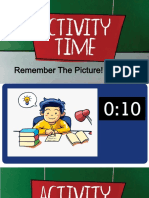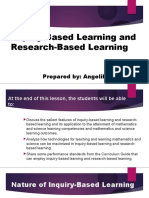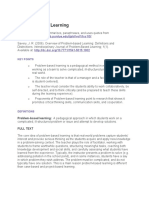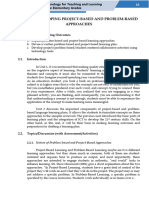TTL2 Outline
TTL2 Outline
Uploaded by
josuah OperarioCopyright:
Available Formats
TTL2 Outline
TTL2 Outline
Uploaded by
josuah OperarioOriginal Description:
Original Title
Copyright
Available Formats
Share this document
Did you find this document useful?
Is this content inappropriate?
Copyright:
Available Formats
TTL2 Outline
TTL2 Outline
Uploaded by
josuah OperarioCopyright:
Available Formats
Problem-Based and Project-Based Learning
INTRODUCTION
This chapter focuses on problem-based and project-based learning, its nature and
importance. Technology role on these two approaches will be discussed. As the technology
becomes important for teaching-learning process, it should be integrated with the different
approaches including problem-based and project-based learning. We will also delve on the several
literature and findings about these two approaches given by some individuals.
Objectives:
Discuss the salient features of Problem-Based Learning and Project-Based Learning and its
application to the attainment of learning competencies and learning outcomes
Analyze how technologies for teaching and learning can be maximized in Problem-Based
Learning and Project- Based Learning
Activity
Without searching on the internet, write 2-3 sentences about physics and calculus. Write your
answer on a ½ sheet of paper. You can do this for five minutes.
Content
Nature of Problem-Based Learning
Problem-based learning is an approach that involves a process of inquiry and solving
open-ended questions that serve as the main problem that the learners will work on.
The type of questions posited is focused on a specific content standard and its
application to real life issues. It also requires more than one answer or solution.
Ali (2019) described PBL as a process that is used to identify problems with a scenario to increase
the knowledge and understanding.
In her research article, she proposed the following five principles of PBL that can be considered by
teachers in planning or using the approach:
1. Independent and self-directed learning
2. Learning happens in a group and teacher is a facilitator
3. All groups have to participate equally.
4. Students’ learn about motivation, teamwork, problem-solving and engagement with the task.
5. Materials such as data, photographs, articles, can be used to solve the problem.
Lo (2009, p. 208) proposed a six-stage process that was used in the adoption of the online PBL
: 1. Identifying the problem – current issues that do not have just one answer or one definite
solution;
2. Brainstorming generate ideas; tackle the problem through selt directed questioning; arouse
students’ intrinsic motivation;
3. Collecting and analyzing the information- assigning group members to collect information;
posting what they found and what they learned; collaborative collection of useful information;
4. Synthesizing information – solving the problem through relevant data synthesized; knowledge
building:
5. Co-building knowledge - presentation of the solution to the learning problem/ issue and;
6. Refining the outcomes - giving of feedback and suggestions by the instructor to help students
improve; learning from other group’s presentation.
Benefits of Problem-Based Learning
In the work of Schettino (2016), PBL in teaching mathematics, group work values all voices and
that a mathematics classroom environment becomes open and safe.
In the study of O’Brien, Wallach, & Mash-Duncan (2011), they proposed that teaching
mathematics should not be taught merely as solving word problems (computational exercises
couched in words) but solve problems outside a math classroom the essence of PBL.
The study of Kim, Belland, & Walker (2018) discussed that PBL is a leaner-centered approach that
aims to improve students’ content knowledge and problem-solving skills using authentic problems.
Role of Technology
Bower, Hedberg and Kuswarg (2010) stresses that technology is simply the mediator for
collaboration and representation and that it is the type of task and thinking processes in which
students engage that determines the quality of learning.
The WWW has affordances for PBL that can be utilized by the learners to accomplish their tasks.
Web 2.0 technologies are characterized by collaboration, sharing and networking. These may
facilitate and enhance PBL activities (Tambouris et al, 2012) in its different stages. In the study of
Tarrant (2018), using Web 2.0 is effective in helping students in health sciences to bridge the gap
between theory and practice.
Also, according to Holmes & Dubinsky (2009), Web 2.0 tools facilitate creativity, collaboration, and
sharing of research results among users.
According to Schettino (2016), PBL in mathematics classrooms promotes the use of technology in
the process of problem solving for the students to become more independent and aware of the
various mathematical resources they can utilize.
Productivity tools such as those for writing, presentations, spreadsheets, calendars, organizers,
citations and others are also available to assist learners and teachers in accomplishing required
tasks and outputs from a PBL activity.
Nature of Project Based learning
PROJECT BASED LEARNING
• Is an approach but has evolved as a teaching method that engages learner’s in a series of
planned tasks resulting to the generation of solutions to real world problem.
• This method is based on John Dewey’s principle of learning by doing and Vygotsky’s
constructivist theory of learning that advocates social construction of knowledge.
• PrBL/PBA is a collaborative learning activity wherein learner’s work on an authentic tasks
guided by an open ended questions.
Past and more recent researchers have proven PrBL to be beneficial in the development of
various skill such as:
RESEARCH METHODOLOGY SKILLS ( TIWARI, ARYA, & BANSAL, 2017)
Using Student feedback questionnaire given to 99 students, it was revealed that students were
enhanced in their knowledge of the topic taken, searching review for the topic, improved
communication skills, data collection skills and analytical and presentation skills when PrBL was
used as component in research methodology.
CRITICAL THINKING SKILLS ( Nargundkar, Sammadar, and Mukhopadhyay, 2019)
The researchers investigated how PrBL advances the critical thinking skills of students. To solve
real life Problems, Students are expected to use the knowledge they had constructed, to think
deeply about the issues, consider evidence for or against a proposed solution, and apply
reasoning skills and logical inquiry to come up with the best solution or conclusion.
DEVELOPMENT OF LIFE SKILLS ( Wurdinger, And Qureshi 2015)
The study employed mixed method to examine the development of life skills through PrBL.Their
findings revealed that after taking the PBL Course,there was a significant differences In the mean
scores for the following life skills: responsibility, problem solving, Self direction, Communication
and creativity skills.
Evaluation
( ¼ Sheet of Yellow Paper)
DIRECTION: Write only the letter of the correct answer.
1. According to them Web 2.0 tools facilitate creativity, collaboration, and sharing of research
results among users.
A. Holmes & Dubinsky (2009) B. Bower, Hedberg and Kuswarg (2010)
C. Wurdinger, And Qureshi 2015 D. Kim, Belland, & Walker (2018)
2. Project Based learning is based on his principle of learning by doing?
A. Lev Vygotsky B. Abraham Maslow
C. John Dewey D. None of the Above
3. It is an approach that involves a process of inquiry and solving open-ended questions that serve
as the main problem that the learners will work on.
A. Problem Based learning B. Project Based learning
C. Both A and B D. None of the above
4. How many stage process does Lo(2009) proposed to used in the adaptation of online PBL?
A. Four B. Five
C. Six D. Seven
5. It is an approach but has evolved as a teaching method that engages learner’s in a series of
planned tasks resulting to the generation of solutions to real world problem.
A. Inquiry Based Learning B. Research Based learning
C. Problem Based learning D. Project Based learning
Key to Correction:
1. A
2. C
3. A
4. C
5. D
Reporters:
Joshua Joy P. Oray
Alexandra L. Cesista
BSED SCI-3
You might also like
- Nature of Problem Based LearningDocument52 pagesNature of Problem Based LearningAlwyn SacandalNo ratings yet
- Revisiting of PB Learning Plan: Integration of The Use of Digital and Non Digital Resources and Assesment Tools in The LP ProcedureDocument12 pagesRevisiting of PB Learning Plan: Integration of The Use of Digital and Non Digital Resources and Assesment Tools in The LP ProcedureReca BoltronNo ratings yet
- Week 5 Learning ResourcesDocument4 pagesWeek 5 Learning ResourcesKim Angela Cordez100% (1)
- TTL 2 HandoutDocument8 pagesTTL 2 HandoutEzra PicaNo ratings yet
- Module 2-Integrating Active Learning Approaches in Social Science LearningDocument8 pagesModule 2-Integrating Active Learning Approaches in Social Science LearningMichael AngelesNo ratings yet
- TTL ReportDocument50 pagesTTL ReportJasher JoseNo ratings yet
- TTL Module 3Document7 pagesTTL Module 3ronelinemalanaNo ratings yet
- Mod 4Document7 pagesMod 4Cleizel Mei FlorendoNo ratings yet
- Lesson 2-WPS OfficeDocument17 pagesLesson 2-WPS OfficeJohn Mark MapusaoNo ratings yet
- TTL 2Document20 pagesTTL 2Hanzel Mae Palomo100% (1)
- Pr0Blem-Based Learning AND Project-Based LearningDocument16 pagesPr0Blem-Based Learning AND Project-Based LearningKay DeeNo ratings yet
- Integrating Active Learning Approaches in Language Learning - PBLDocument15 pagesIntegrating Active Learning Approaches in Language Learning - PBLrenair ravaloNo ratings yet
- Problem Based and Project Based LearningDocument8 pagesProblem Based and Project Based LearningJessie Mae Jauod OlaoNo ratings yet
- Tugas Mata Kuliah Model Pembelajaran Bahasa Kelas B Kelompok 2 - RevDocument17 pagesTugas Mata Kuliah Model Pembelajaran Bahasa Kelas B Kelompok 2 - RevTri Wahyuni PurwaningsihNo ratings yet
- The Effects of The Implementation Problem Oriented Learning Modules Implications For Teaching TechniquesDocument12 pagesThe Effects of The Implementation Problem Oriented Learning Modules Implications For Teaching TechniquesBella SakedanNo ratings yet
- Problem Based Learning and Project Based LearningDocument19 pagesProblem Based Learning and Project Based Learninggwapak249No ratings yet
- Inquiry and Research FINALDocument23 pagesInquiry and Research FINALAngelika SericonNo ratings yet
- Problem Based Learning and ApplicationsDocument9 pagesProblem Based Learning and ApplicationsArielle EstefaniNo ratings yet
- Luke Ranieri rtl2 Assessment 2Document18 pagesLuke Ranieri rtl2 Assessment 2api-486580157No ratings yet
- Enhanced and Conventional Project-Based Learning in An Engineering Design ModuleDocument22 pagesEnhanced and Conventional Project-Based Learning in An Engineering Design ModuletnngondaNo ratings yet
- Problem Solvin Mind MapDocument7 pagesProblem Solvin Mind MapDin Aswan RitongaNo ratings yet
- Chapter-1-2-3Document86 pagesChapter-1-2-3afcaro.uiNo ratings yet
- IISTE Journals November Edition PublicatDocument15 pagesIISTE Journals November Edition PublicatNEWTON NINDY CARMELIA BURNAMANo ratings yet
- Project-Based Learning: Lead SectionDocument9 pagesProject-Based Learning: Lead SectionLaeh SaclagNo ratings yet
- TTL 2 ReportDocument16 pagesTTL 2 ReportlxcnpsycheNo ratings yet
- Blue Computer Icon Background Technology PresentationDocument9 pagesBlue Computer Icon Background Technology Presentationkate.aquinoNo ratings yet
- Reviewer For Final Examination in Teaching Technology in Elementary GradesDocument9 pagesReviewer For Final Examination in Teaching Technology in Elementary Gradestoriojocelyn16No ratings yet
- Unit 2 AB CDocument10 pagesUnit 2 AB CElluzel Mae BeceraNo ratings yet
- Problem-Based LearningDocument13 pagesProblem-Based LearningEstela BenegildoNo ratings yet
- Methods of TeachingDocument57 pagesMethods of TeachingRex Rieta Villavelez100% (1)
- Learning Through Projects in The Classroom: Project-Based Learning GuideDocument16 pagesLearning Through Projects in The Classroom: Project-Based Learning Guidedierksbentley89No ratings yet
- Effectiveness of Problem-Based Learning Implementation: KeywordsDocument13 pagesEffectiveness of Problem-Based Learning Implementation: KeywordsImmas Andaru WinantiNo ratings yet
- TTL 2-MATH: Lesson 4Document7 pagesTTL 2-MATH: Lesson 4Efraem CelesteNo ratings yet
- Integrating Active Learning Approaches in Language LearningDocument5 pagesIntegrating Active Learning Approaches in Language LearningGemmarie Roslinda PasionNo ratings yet
- Konsep FilsafatDocument8 pagesKonsep Filsafathafidh ainunNo ratings yet
- Applying Learning Design Concepts To Problem-Based Learning: Macquarie University, AustraliaDocument10 pagesApplying Learning Design Concepts To Problem-Based Learning: Macquarie University, AustraliaalhanunNo ratings yet
- Development of Problem-Based Student Worksheet With Authentic Assessment To Improve Student's Physics Problem Solving AbilityDocument9 pagesDevelopment of Problem-Based Student Worksheet With Authentic Assessment To Improve Student's Physics Problem Solving AbilityMeuretta Alawiyah PulunganNo ratings yet
- Aktas-Project 3Document5 pagesAktas-Project 3api-242938257No ratings yet
- A Review of Problem Based Learning 1Document9 pagesA Review of Problem Based Learning 1api-291733007No ratings yet
- The Effectiveness of Problem Based Learning (PBL) Model On Students' Learning Outcomes at Class Xi Ipa 2 of Senior High School 5 South Konawe On The Subject of Colloid SystemDocument12 pagesThe Effectiveness of Problem Based Learning (PBL) Model On Students' Learning Outcomes at Class Xi Ipa 2 of Senior High School 5 South Konawe On The Subject of Colloid SystemNoviParentaMasirriNo ratings yet
- 66) VI18-1142 - Full Paper-Abigail Melad EssienDocument6 pages66) VI18-1142 - Full Paper-Abigail Melad EssienP'ng Fei MunNo ratings yet
- Active Learning Approaches For Language LearningDocument32 pagesActive Learning Approaches For Language LearningJohn Michael LaurioNo ratings yet
- Project Based Learning and Learning EnvironmentsDocument8 pagesProject Based Learning and Learning EnvironmentsYunita Dwi FebriastutiNo ratings yet
- FulltextDocument63 pagesFulltextFRANCISCO, Albert C.No ratings yet
- PJBL - Kelompok 7Document14 pagesPJBL - Kelompok 7Manda Adelia ANo ratings yet
- Additional Reference For Unit 2 EEd 14Document12 pagesAdditional Reference For Unit 2 EEd 14melrian.almojenoNo ratings yet
- Gangadharpur Sikshan Mandir: ContentDocument6 pagesGangadharpur Sikshan Mandir: ContentKUTUBUDDIN MOLLANo ratings yet
- TTL 2 Presentation 2Document22 pagesTTL 2 Presentation 2BLESLYN CLAIRE LORENZO A.No ratings yet
- Project Based ApproachDocument27 pagesProject Based ApproachLaura100% (4)
- Using Space in Social MediaDocument12 pagesUsing Space in Social MediaThị Kiều hoa PhanNo ratings yet
- 339 863 2 PBDocument23 pages339 863 2 PBAndri WicaksonoNo ratings yet
- What Is Project BasedLearningDocument4 pagesWhat Is Project BasedLearningdarlene sarmientoNo ratings yet
- Developing Module On Constructivist Learning Strategies To Promote Students' Independence and PerformanceDocument11 pagesDeveloping Module On Constructivist Learning Strategies To Promote Students' Independence and PerformanceJenrick F. RosarieNo ratings yet
- Enhancing Students Problem Solving Skills ThroughDocument14 pagesEnhancing Students Problem Solving Skills Throughsalie29296No ratings yet
- Lesson 3 TTL2Document47 pagesLesson 3 TTL2fries riveraNo ratings yet
- 3 ContentDocument93 pages3 ContentAris AnandaNo ratings yet
- Impact of PBL On Student Centric Learning: AbstractDocument8 pagesImpact of PBL On Student Centric Learning: AbstractAgha Khan DurraniNo ratings yet
- Chapter 1 IntroductionDocument12 pagesChapter 1 Introductiontira kristyNo ratings yet
- Edtc605 Simala Final ProjectDocument21 pagesEdtc605 Simala Final Projectapi-527185512No ratings yet
- Learning Plan # - 1 - : Infant Jesus Academy of Silang, IncDocument2 pagesLearning Plan # - 1 - : Infant Jesus Academy of Silang, IncJenine SipaganNo ratings yet
- ECEGradManual 20170615Document24 pagesECEGradManual 20170615Ougni ChakrabortyNo ratings yet
- 16501-Article Text-49650-1-10-20210531Document9 pages16501-Article Text-49650-1-10-20210531blackyugaiNo ratings yet
- Uganda Pilot ProjectDocument2 pagesUganda Pilot ProjectPEIC DataNo ratings yet
- Integrated Lesson PlanDocument14 pagesIntegrated Lesson Planapi-565965351No ratings yet
- Brosura-Program GIDNI IDocument87 pagesBrosura-Program GIDNI IFausta_BorgiaNo ratings yet
- The Paradox of Diversity Management, Creativity and InnovationDocument7 pagesThe Paradox of Diversity Management, Creativity and InnovationVishnu VikramNo ratings yet
- NSV Empanelled Providers List District: Kancheepuram YEAR: 2019-20 (As On 16.12.2019)Document5 pagesNSV Empanelled Providers List District: Kancheepuram YEAR: 2019-20 (As On 16.12.2019)CHANDRAN MAHANo ratings yet
- Development and Acceptability of Introduction, Methodology, Results and Discussion (Imrad) Style As A Guide in Writing Research ReportsDocument11 pagesDevelopment and Acceptability of Introduction, Methodology, Results and Discussion (Imrad) Style As A Guide in Writing Research ReportsMa. Lourdes CuaresmaNo ratings yet
- IRSE Route To Registration Flowchart (UKSPEC4)Document1 pageIRSE Route To Registration Flowchart (UKSPEC4)bassamNo ratings yet
- Letter Formats Full Block Format: Every Component of The Letter (Heading, Address, Salutation, BodyDocument3 pagesLetter Formats Full Block Format: Every Component of The Letter (Heading, Address, Salutation, BodytejaswiniNo ratings yet
- Plant Life Cycle LessonDocument3 pagesPlant Life Cycle Lessonapi-300472292100% (1)
- 32-KVS RO Guwahati Escort & Coaching Camp Duty 2019 PDFDocument6 pages32-KVS RO Guwahati Escort & Coaching Camp Duty 2019 PDFAmisha LagwalNo ratings yet
- NALSAR BA LLB (Honours) SyllabusDocument8 pagesNALSAR BA LLB (Honours) SyllabusKudoShinichiNo ratings yet
- Y1 Homework SheetsDocument6 pagesY1 Homework Sheetsafetneoqy100% (2)
- 2020 Iscea Ptak Prize: 20 June, 2020Document2 pages2020 Iscea Ptak Prize: 20 June, 2020Ahmed ZohairNo ratings yet
- Resumedraft 3Document1 pageResumedraft 3api-645196535No ratings yet
- 08 LX21b MSP 2011 Practitioner Sample Paper v1.2 - QuestionsDocument26 pages08 LX21b MSP 2011 Practitioner Sample Paper v1.2 - Questionsmaheshkzm100% (1)
- MenuItem2023 202420School20Calendar PDFDocument1 pageMenuItem2023 202420School20Calendar PDFJDTHEGOAT DancearNo ratings yet
- PCG Human Services Infographic: The Real Cost of Child Abuse and Neglect'Document1 pagePCG Human Services Infographic: The Real Cost of Child Abuse and Neglect'Public Consulting GroupNo ratings yet
- Web MiningDocument10 pagesWeb MininggopitheprinceNo ratings yet
- Variation Within A Population TEACHER NOTES (Day 4 5)Document1 pageVariation Within A Population TEACHER NOTES (Day 4 5)Anonymous Sew0l8RNo ratings yet
- EDUC. 104 Chapter 14Document2 pagesEDUC. 104 Chapter 14Liezel ArdalesNo ratings yet
- Grama Bharathi Eng BroucherDocument14 pagesGrama Bharathi Eng BroucherVeeru popuriNo ratings yet
- Ibdp Exam Nov.2017 (TT)Document2 pagesIbdp Exam Nov.2017 (TT)Harshil ChordiaNo ratings yet
- Resume RealDocument2 pagesResume RealKurt Ronald SanJuan EstebanNo ratings yet
- Curriculum Vitae: MD Shah Hussain EmailDocument3 pagesCurriculum Vitae: MD Shah Hussain EmailibrahimNo ratings yet
- BAJA (2017) Virtual Round Results!!Document9 pagesBAJA (2017) Virtual Round Results!!Anonymous XsQJE44No ratings yet
- Full TextDocument17 pagesFull TextKartiko BimoNo ratings yet
























































































